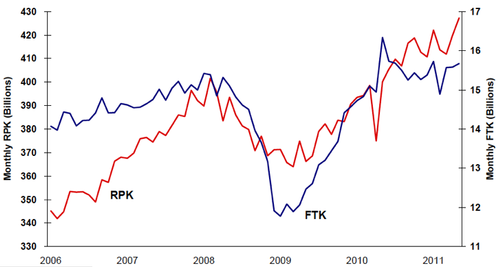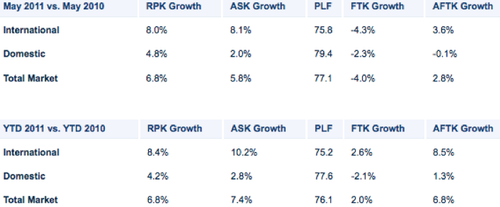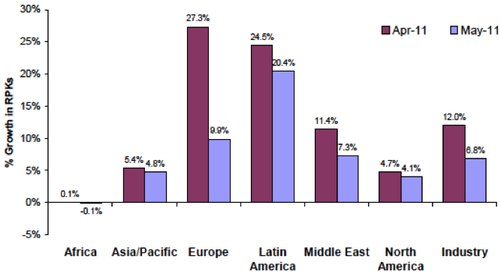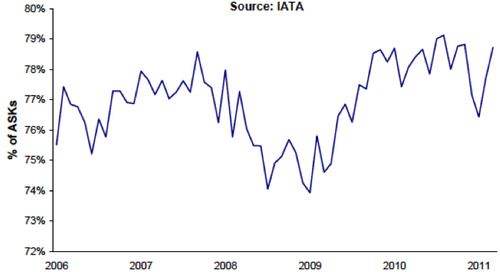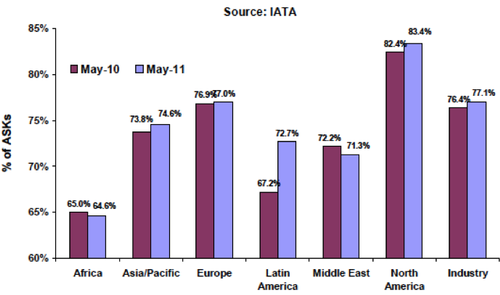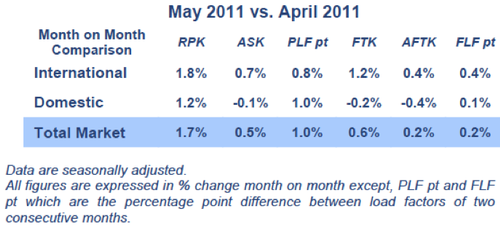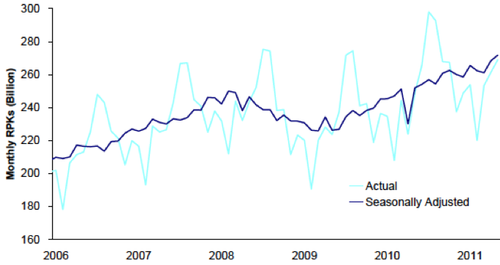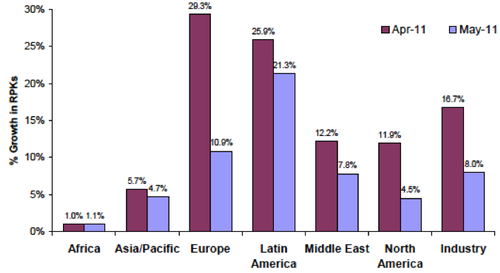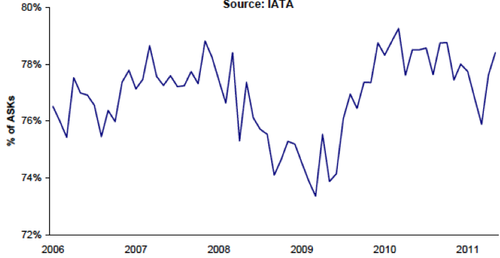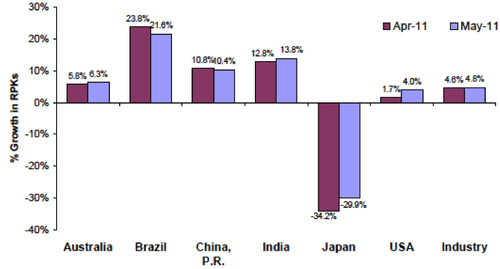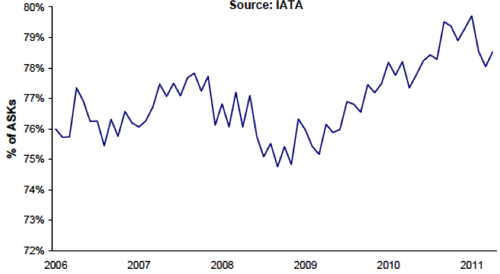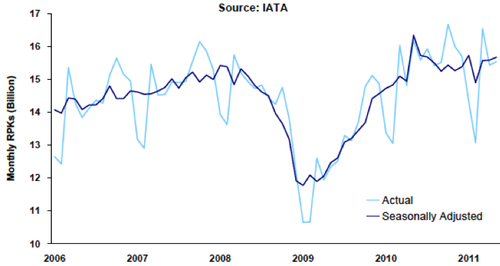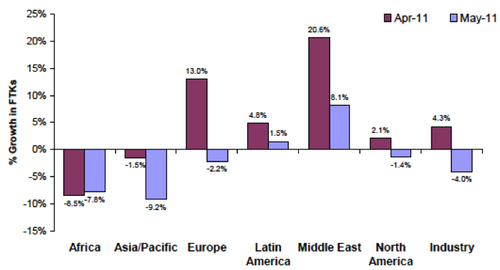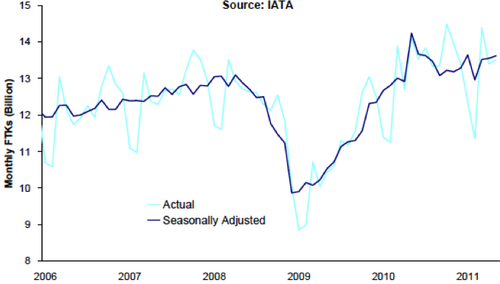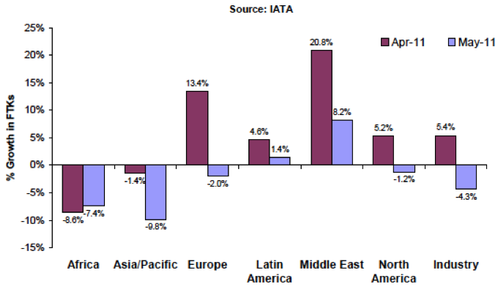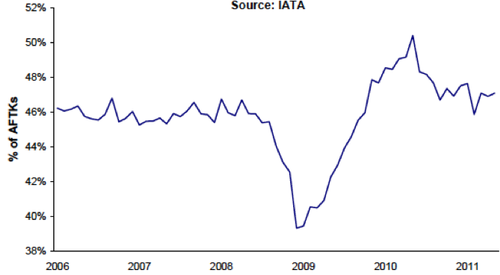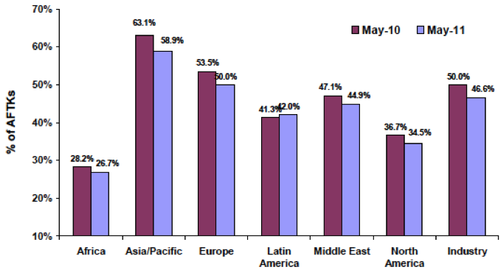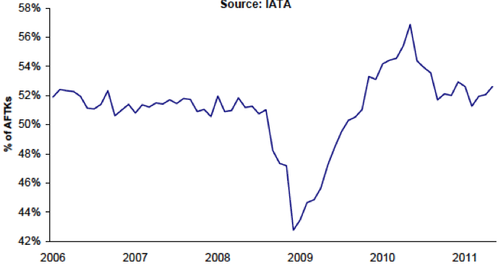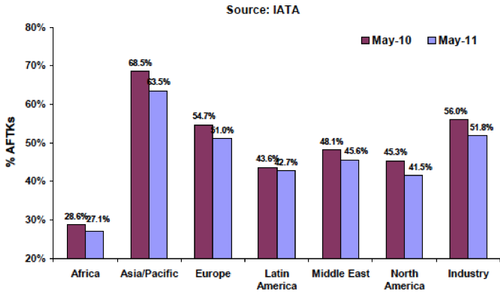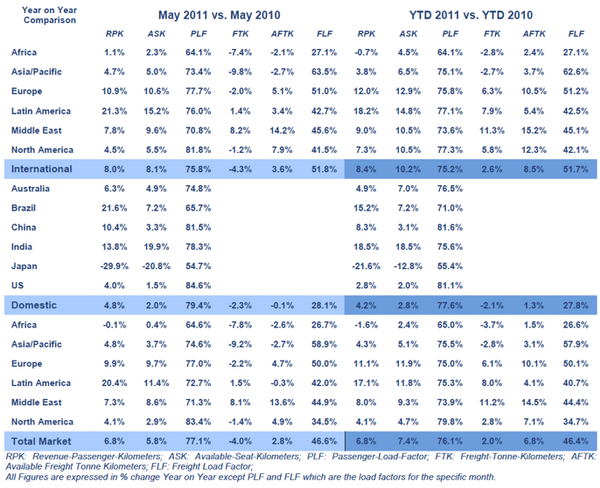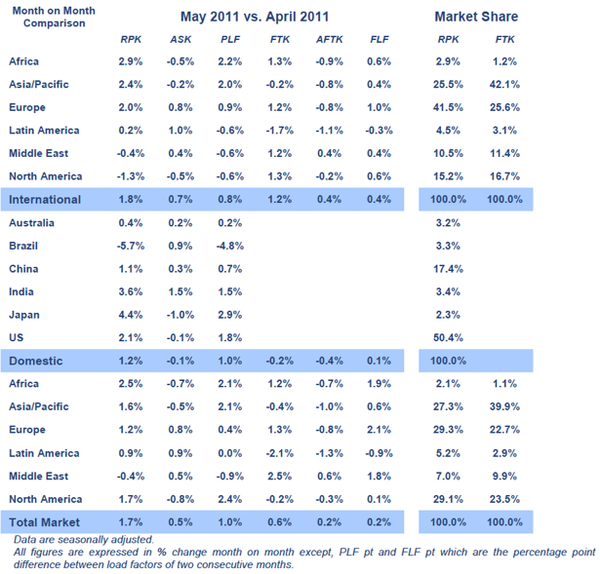Global air traffic demand improves in May-2011 but risks remain: IATA
International passenger traffic recorded renewed expansion in May-2011, after a soft patch during the preceding three months. Traffic increased 6.8% year-on-year in May-2011 to be 4% higher than at the beginning of the year. Conversely, freight traffic declined 4% against the post-recession peak of the restocking cycle in May-2010. However, recent months show a renewed upward trend following weakness over the past three months with freight volumes now 2% higher than at the start of 2011.
Total Air Freight and Passenger Volumes (seasonally adjusted)
The positive developments in air transport volumes in May-2011 will help to alleviate some of the pressure on profits from continued high fuel prices, IATA's Director General and CEO Bisignani Giovanni said. "But there are risks associated with political unrest in the Middle East and the European currency crisis. We still expect the industry to make USD4 billion this year. That is a pathetic 0.7% margin and another shock could alter the industry's fortunes dramatically. It's another tough year for a very fragile industry," he cautioned.
IATA May-2011 traffic results
Traffic expansion enters slower pace
While air transport demand is continuing to expand during 2Q2011, the expansion of air travel has entered a slower phase since 4Q2011. Up to that point the post-recession expansion had been at an average annualised pace of more than 8%.
Since 4Q2010 the trend, through a very volatile month-to-month path, has been at an annualised pace of 4%. If growth in the remaining seven months of the year carries on at that pace, then average 2011 growth would be 5.9%. IATA's current forecast of 4.4% for 2011 anticipates slower growth in the trend during 2H2011, due to slower economic growth and the impact of high fuel prices.
Seasonally-adjusted, the size of the air travel market (in RPK terms) was 4% higher in May-2011 than the end of last year, and 6.8% higher than May-2010.
Total passenger market (domestic and international): 2006 to 2011
Large regional differences remain in traffic trends
Large regional differences remain in traffic trends. The passenger traffic carried by African airlines has rebounded strongly since Feb-2011 but since the decline was significant, the year-on-year comparisons still look weak.
Asia Pacific airlines show much variation within the region but overall the still weak Japanese markets are holding down growth for the region as a whole. Latin American airlines saw the fastest growth in their markets in May-2011, as strong economic growth and expanding trade boosted both domestic and international markets for these airlines. In between were airlines from Europe and the Middle East. Unusually, European airlines added capacity and passenger traffic at a faster rate than airlines from the Middle East in May-2011.
Total Passenger Growth by Region
Load factors rebound strongly in May-2011
Load factors also rebounded strongly during May-2011, continuing the partial recovery seen in Apr-2011, meaning that over the preceding two months, all of the previous losses were recoverred. This is partly the result of a more stable addition of capacity compared with the recent fall then rise in traffic. Nonetheless, passenger load factors were no higher than a year earlier and slightly down on 3Q2011 levels. Meanwhile, assets are, concerningly, starting to be under-utilised, particularly on freight markets, putting downward pressure on airline profitability compared to the peak in 3Q2010.
Passager Load Factor on Total Market: Seasonally Adjusted
Total Passenger Load Factor by Region
Traffic up on a month-on-month basis
On a month-on-month basis, both international and domestic air travel rose strongly in May-2011, partly due to rebounds from earlier demand shocks. Moderate capacity expansion led to a significant improvement in load factors. Meanwhile, domestic freight remains soft but there was an encouraging rise in international freight volumes.
May-2011 traffic vs Apr-2011 traffic
International travel markets stronger than domestic markets
International travel markets were stronger than domestic markets in May-2011 as still robust international trade and investment flows have sustained business travel and the growth of international air travel. International passenger markets have grown 8% over the past year, compared to 4.8% growth on domestic markets. International markets are 5% higher than the end of 2010, compared with an expansion of just over 1% for domestic markets.
The strength in international markets is also partly due to a strong rebound in the traffic carried by African airlines, following the sharp decline in Feb-2011 at the onset of the unrest in Egypt and Tunisia. Flights and travel remain below normal for those markets but for the African airlines traffic volumes have rebound 16% from the Feb-2011 lows to a point just under 5% weaker than pre-unrest levels.
International Passenger Market
Airlines from other emerging regions in Asia Pacific and Latin America were also expanding strongly in May-2011. A divergence is developing between airlines in Europe and North America. European airlines, despite some very weak home economies, expanded both capacity and traffic strongly in May-2011 by over 10%. In contrast North American airlines have been cutting international capacity for the past two months and seeing much slower growth in traffic.
International Passenger Growth by Region
As traffic has rebounded sharply, load factors have also recovered the majority of previous losses on international markets. Seat utilisation on international markets is still slightly down on the peaks of 2010, but the impact on unit revenues and supply-demand conditions will be very positive for 2Q2011 results compared with 1Q2011.
Passenger Load Factor on International Market Seasonally Adjusted
With the most consistently cautious capacity additions on international markets, airlines from North America have also sustained the highest load factors. Load factors remain the weakest for the African airlines which will make it much harder, in the face of high fuel costs, to sustain profitability.
International Passenger Load Factor by Region
Most domestic travel markers up strongly in May-2011
Despite growth being less dynamic in the domestic market, most domestic travel markets were up strongly in May-2011. The size of domestic markets in May-2011 were however no higher than it was at the end of 3Q2010.
Domestic Passenger Market
However, within that total there are very different market experiences. The large US domestic market, which represents half of the total, saw relatively good growth, rising 4% year-on-year, despite the concerns expressed recently about a faltering in the US economy. However, by contrast with the emerging markets this very mature market is still growing very slowly.
Domestic Passenger Growth by Country
Japan's domestic recovery from the 11-Mar-0211 earthquake and tsunami could have started in May-2011, according to IATA, with a 4.4% month-to-month rise, although there is a long way to go with levels still down by almost 30% on a year-on-year basis.
At the other extreme is the volatile Brazilian market, up above 20%. Strong growth also continued to be evident in the Indian domestic market, boosted by the strong economy, with year-to-date growth of 18.5% - the strongest domestic market in 2011 so far. The Chinese market has slowed, although remains more than 10% up on last year, under the influence of tightening economic policy.
Load factors remain much lower than late last year on average for domestic markets. A significant part of this is due to the situation in Japan, where load factors were only 54% in May-2011. Despite the rapid expansion of capacity in the Indian domestic market the growth in travel demand has been so strong that load factors remain high at close to 80%. In China, airlines have sharply slowed capacity additions keeping their load factors even higher.
Passager Load Factor on Domestic Market Seasonally Adjusted
Domestic Passenger Load Factor by Country
Freight market showing signs of renewed expansion
Having stagnated for almost a year, after peaking in May-2010, the air freight market is finally showing signs of renewed expansion.
Air freight markets showed a 4.0% decline in May-2011. This is skewed as a result of the May 2010 peak for of the post-recession restocking cycle. Since the beginning of the year, freight volumes have increased by a modest 2.0%. This is lower than the 5.5% IATA forecast for 2011. The trend now visible through the volatility of Jan-2011 and Feb-2011 reveals annualised growth of just over 4% between 4Q2010 and May-2011.
If this pace of growth persisted through the remaining seven months of 2011, then average growth in 2011 would be less than 3%, which is considerably weaker than the 5.5% growth IATA is currently forecasting. Since world trade is still growing at a pace of 6% there remains the scope for acceleration in air freight in 2H2011, according to IATA. However, IATA noted that "at present it certainly looks as though our current forecast for freight growth looks too high".
Total Freight Market
Total Freight Growth by Region
Just as in the passenger market, international air freight markets are doing better than domestic. Despite volatility at the start of 2011, international air freight volumes have been growing at a pace of more than 6% between the end of 3Q2010 and May-2011, which is close to the trend of the past 20 years.
International Freight Market
International Freight Growth by Region
Meanwhile, freight load factors rose a little in May-2011 on international air freight markets. However, the level of freight capacity utilisation in May-2011 was still 4% points lower than the peak in May-2010. More importantly the trend over the past six months still appears to be downward, as capacity is brought on to the market at a faster pace than the rebound in traffic volumes.
Freight Load Factor on Total Market: Seasonally Adjusted
Total Freight Load Factor by Region
Freight Load Factor on International Market Seasonally Adjusted
International Freight Load Factor by Region
APPENDIX: IATA May-2011 traffic results
Passenger markets by region: May-2011
|
Region |
International passenger markets |
Domestic passenger markets |
Freight (domestic and international) |
|---|---|---|---|
|
International traffic increased 1.1% year-on-year. Travel markets to the region had been depressed by the impact of political unrest in Egypt and Tunisia. Flights to these two destinations are still about 20% down. However a significant 2.2 ppt improvement in the load factor for the month does show initial signs of improvement. |
Air freight carried continues to be severely reduced by recent events. Declines of 7.8% year-on-year reflected the disruption in Egypt and Tunisia. |
||
|
Recorded an expansion of 4.7%, considerably below the global average of 8.0%. This is due to continuing weakness in the post-earthquake/tsunami Japanese market. Compared with May-2010, capacity expanded 5.0% and the load factor fell slightly to 73.4%. |
Japanese domestic demand declined 29.9% year-on-year while capacity has been adjusted downwards by 20.8%. Total volumes in May-2011 were 4.4% higher than in Apr-2011, showing the initial signs of recovery from the earthquake and tsunami. But the low 54.7% load factor indicates the continuing mismatch between supply and demand. In China, demand increased 10.4% year-on-year. A capacity expansion of just 3.3% resulted in load factors of 81.5%. While this is still robust growth, it is a major ramping down from the 14.6% recorded in 2010, reflecting tighter economic policies. India domestic demand increased 13.8% year-on-year on a 19.9% capacity (ASKs) expansion. The load factor of 78.3% is consistent with the global average of 79.4%. |
Air freight carried continues to be severely reduced by recent events. The largest fall was for Asia-Pacific carriers with a 9.2% drop showing the impact of disrupted supply chains in Japan and tighter economic policies in China. |
|
|
Traffic expanded by 10.9%, boosted by increased northern European economic activity and a weaker Euro encouraging trade and inbound travel. Capacity expanded by 10.6%, second only to Latin America, and the load factor strengthened to 77.7% |
The sharp fall in the year-on-year comparison for European airlines reflects the upwards distortion last month by the comparison with the volcanic ash affected month the previous year. In addition strong export growth from Northern European capital goods producers, benefiting from the weak euro, have also boosted air freight for airlines based in this region. |
||
|
Saw the fastest international growth, up 21.3% year-on-year and the fastest capacity expansion (15.2%). This is a consequence of strong economic growth and increased travel and trade flows to North America and across the Pacific. The load factor is just above the industry average at 76.0%. |
Brazil remains volatile but demand is up 21.6% year-on-year while capacity was 7.2% higher. The volatility of the market is evident in a 65.7% load factor even with the demand outstripping capacity by such a wide margin |
Continued strong cargo growth for airlines the region reflects the strong economic growth in many of the economies in the regions. Was one of two regions to witness freight growth, with freight up 1.5% year-on-year |
|
|
International traffic increased by 7.8% over May-2010, slightly below a 9.6% capacity expansion that saw load factors slip to 70.8%. While political unrest continues to have a dramatic impact on several of the region's smaller markets, the overall impact on the region's carriers is very limited |
Continued strong cargo growth for airlines the region reflects the strong economic growth in many of the economies in the regions |
||
|
North American carriers have cut capacity for two consecutive months (-0.4% in Apr-2011 and -0.5% in May-2011). Year-on-year, traffic is up 4.5% and capacity increased by 5.5%. This cautious approach to capacity expansion resulted in the highest load factor (81.8%) among the major regions. |
The mature US domestic demand grew by 4.0% year-on-year. Against a 1.5% increase in capacity, load factors were pushed to 84.6%, the highest among domestic markets surveyed. |
North American carriers reported a modest 1.4% decline |
IATA international traffic year-on-year comparisons
IATA international traffic month-on-month comparisons
